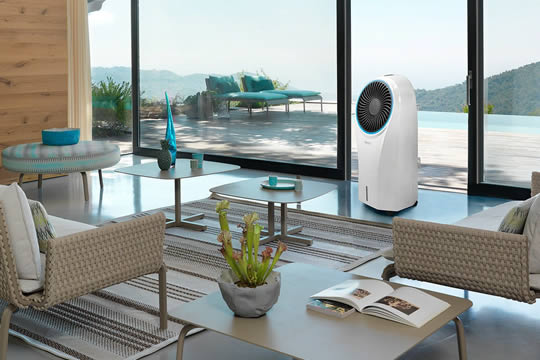How Effective are Evaporative Coolers?
With all the current concerns over energy costs, switching to a lower-cost cooling solution is a must. But how effective are evaporative coolers as cheap way to stay cool in summer?
Let's take a look at what we already know. That is air conditioners are great for cooling a room or an entire home, but they cost a lot to run because they use a lot of electricity.
 AC can take the form of window units, central air, zone ductless mini-split units or portable units.
AC can take the form of window units, central air, zone ductless mini-split units or portable units.
These systems can all cool you down very effectively, but they are also energy-intensive when getting the job done.
Air conditioning is expensive and all that energy consumption contributes indirectly to global warming.
This creates a self-fulfilling scenario where we will all need more powerful air conditioning to cope with the additional heat, which will use more energy and cost more money.
This is before we can get to the complex and often negative contributions of chemical refrigerants to the environment. So what's the alternative?
Evaporative Cooling
Evaporative cooling (PDF), which is energy-efficient and free from refrigerants, is a viable and effective alternative to using a lot of energy to stay cool in summer.
There are many ways to benefit from natural evaporative processes. However, the most common way is to buy (or even build) an evaporative cooling device.
This type of cooler, also known as a swamp cooler or similarly, a portable ventless air conditioner, uses a fan to circulate the air through a cool, damp pad and then expel the freshly moistened air into the room.
It's very similar to the fan-mounted spray bottles that you can often see used in some restaurants or on patios, but on a larger scale.
These swamp coolers are actually effective in the right circumstances. Yet why isn't everyone using them to stay cool?
Pros and Cons of Evaporative Cooling
Evaporative cooling is loosely inspired by the perspiration process we all experience in hot weather.
The body automatically cools down by releasing water through the skin. A pleasant breeze picks up the moisture and returns you to a comfortable temperature.
The same thing happens when you run a sprinkler and the air around it feels cooler. This is basically what a swamp cooler does to the air inside a room.
However, it is important to consider how the room's ambient environment will affect how cool you feel. Now let's look at the pros and cons of evaporative cooling.
Advantages (Pros)
The main advantages of swamp coolers is that the cool the air very cheaply, often running at under 200 watts, compared to the 1-2 kW consumption of similarly sized air conditioners.
This can represent a huge saving on the cost of ever-rising electricity bills throughout the hot season.
Evaporative coolers also require minimal maintenance to keep them running at peak efficiency.
Another plus point is that while cooling, these devices humidify the air, making it feel more pleasant on the skin and healthy for breathing. Unfortunately, this advantage leads to this type of cooler's major disadvantage.
Disadvantages (Cons)
While the occupants of a room can enjoy the benefit of cool, moist air for a while, the cooling process employed by these coolers will continue to raise the humidity in the room.
As the air becomes ever more humid, its ability to absorb more moisture is reduced. Since part of the cooling process relies on air absorbing moisture, the less that can be absorbed, the less cooling effect is felt.
This degradation in cooling continues until the air reaches saturation point (100% humidity) where the cooling effect ceases altogether.
The common solution to this problem is simply to open a window or two to allow for a cross breeze of outdoor air to carry the excess moisture away and allow the cooling to continue.
However, in areas where the outside relative humidity is already very high (greater than 60%), the ability for air to absorb moisture is reduced and therefore, the swamp (evaporative) cooler's ability to cool the air is also reduced.
The bottom line here is that if you live in an area with high humidity, a swamp cooler is not an effective cooling option. On the other hand, if your air is relatively dry in summer, you are in luck, because an evaporative cooler is a very effective cooling solution for you.
Why Climate Affects Evaporative Coolers
Much research as gone into this problem and results prove the humidity level is the main factor in swamp cooler effectiveness.
Swamp coolers cool a room slowly, but steadily, although not as effectively as portable air conditioners. The humidity is also increased by 2-3% for every degree the temperature is lowered.
The cumulative effect is a steady rise in humidity until saturation is reached and the cooler's ability to cool is rendered ineffective.
On the other side of the coin, window and portable air conditioners de-humidify spaces as part of their cooling process. This allows them to be much more effective in humid conditions.
Both types of cooler can keep you cool in the right conditions, but they use different methods.
The US Department of Energy (DOE) states that an evaporative cooler can reduce ambient temperature by 5-15 degrees. However, even the DOE insists that it only works in low humidity areas.
Summary
Where the average humidity is below 60%, evaporative cooling can be an effective and affordable way to add some much-needed chill to your summer.
They also make very effective patio coolers, since the use so little electricity for a high output of chilled air.
However, a swamp cooler is not a good choice for places with high humidity. This, unfortunately comprises most of the United States apart from predominantly dry areas like desert locations and much of the southern mid-west.
Posted: April 22, 2022
[Back to Top]